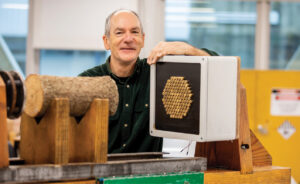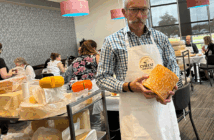
Dr Bill Heffernan from University of Canterbury’s Electric Power Engineering Centre (EPECentre), showcasing a proof-of-concept Smart Electrode for rapid determination of the properties of logs
New Zealand’s dairy factories could be the big winners from a proposed new electromagnetic detection and imaging method aimed at boosting food safety systems.
The super-sensing method is being worked on by a multidisciplinary team of researchers from the University of Canterbury, Lincoln Agritech, University of Auckland and FoodSouth, along with international collaborators in Australia and the UK.
Research on Joule heating techniques for logs, conducted at the University of Canterbury’s Electric Power Engineering Centre, is paving the way to improve imaging technology
with wider applications beyond the timber industry. Bypassing electricity from one electrode through a piece of wood to a segmented electrode array, researchers have been able to produce images showing the internal structures of wood, and now this same technology is being investigated for the food industry.
“This is one half of the story on this new electromagnetic tomography method we now hope to develop for food safety and quality applications,” says University of Canterbury senior research engineer Dr Bill Heffernan.
The goal is to develop this innovative new method so it can reliably determine the electrical conductivity distribution of food mixtures – such as milk – moving through a processing line. Foreign objects such as pieces of metal or plastic could then be quickly identified by their different electrical conductivity characteristics. This method could also be used to scan and image milk or other foods for attributes such as lumpiness, consistency, and temperature, thereby providing reliable quality control assurance.
One of the big challenges for researchers will be to apply the method to fast-flowing product mixtures, as opposed to a stationary item. A key research goal will be to produce a working prototype that could then be tested. Organisations aligned with this exciting project are New Zealand Food Safety, Synlait, TipTop, InFact Ltd, Westland Milk Products Ltd, Waiu Dairy, Miraka Ltd, Hellers Ltd, PDV Consultants and Fonterra.
“Super-sensing has obvious applications for foods such as milk or yoghurt but could also be applied to a product like sausage meat to check food safety and consistency during processing,” Dr Heffernan says.
Current systems include metal detectors, magnets, filtering, temperature sensors and direct sampling, but a new method now under investigation could effectively replace and improve many existing safety and quality checks for foods such as milk, ice cream and sausage meat.
GM of Innovation at Miraka, Brendan Haigh, says the new technology has two potential applications in their processing plants.
“One of the key things is that this will allow us to look inside stainless steel which is pretty much the holy grail of understanding processes. When you walk into a dairy factory, all you can see is stainless steel everywhere and it is hard to understand what is going on inside.
“We produce about 15 million litres of UHT for export to China and we have a couple of areas in our business this technology will be useful for. One is around fouling (the undesirable deposit formed on the surface of the stainless-steel wall during the heating of milk in a heat exchanger) and so we think this technology will provide us with information about how fouling occurs.”
This would also mean operators could have a better idea of when it is necessary to stop processing for cleaning.
A second application could be to collect information that would help determine what sort of milk created the most fouling.
“One of the big challenges for New Zealand UHT manufacturers is that sometimes some milk is better for making UHT than others, and part of that reason is that some milk causes fouling to happen more quickly than other milk. We would really like to understand that further,” Haigh says.
“Miraka is quite keen to support those sorts of projects. We’re only a young company and we’ve only been around 11 years, but we have been involved in quite a few government-funded projects because we need to be innovative. That’s another reason why we’ll continue to support these kinds of projects.”




























































































